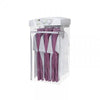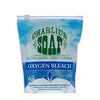According to State Farm Insurance Statistics, washing machine hose failures cause approximately $170 million in damages to homes in the United States & Canada. The true figure may be even higher, as this amount accounts for reported claims only. Fortunately, there are some simple, quick and inexpensive steps that homeowners can take to eliminate the problem.
A failure at 70 pounds of pressure can disgorge up to 650 gallons of water per hour. The problem is that most washing machine hoses are poorly constructed and offer very little in the way of protection. The key is to understand why hoses fail. Contrary to popular perception, hoses do not simply burst due to high water pressure.
Rather than simply bursting, washer water hoses fail in a very specific place- the coupling. The truth is that standard hose couplings are rolled and stamped from a thin sheet of copper alloy. In time, water flow hones them to a fine edge. When the washer water hoses bend at the coupling, this sharp edge is forced into the exterior wall and slices it open. This is called “razoring.”
Unfortunately, most people assume that installing a braided stainless steel hose (steel braided hose) will solve the problem. Even worse, many so-called “experts” believe this to be true. Marketing people take advantage of consumer ignorance by marketing them as “burst-proof.”
Metal hoses, like most rubber hoses, are built to fail. In order to secure the rubber tube and steel braid to the swivel, the manufacturers must use an aggressive crimp and a relatively thin rubber tube. When the hoses are bent and flexed, they fail at the crimp point. In fact, the crimp pushes the steel braiding directly into the single, un-reinforced rubber tube. Since the steel braided hoses are POROUS, once the rubber tube is severed there is nothing to prevent the water from pouring out.
Washing machine maintenance steps you can take to prevent hose failures:
- Regularly inspect your washing machine hoses;
- Make sure there are at least 4 inches of clearance between the water connection and the back of the washing machine. This space will help reduce the chances that the hose will kink.
- Make sure your connections are secure.
- Buy a high quality hose. There is one type of hose (Floodchek) that was originally designed for use in condominiums. It contains a non-corroding rounded brass insert and several other features which were specifically designed to address the shortcomings found in most washing machines.
- Shut off your hoses when not in use. You can either shut them off manually each time, or install an automatic washing machine shutoff valve, such as the Watts Intelliflow.
- Never leave your washer on when you are asleep or out of the house.













